When discussing open-source relational database management systems (RDBMS), both PostgreSQL and MySQL stand out as highly popular choices, widely utilized in the industry for their robust features, extensive administration tools, and well-documented programming APIs. Despite their similarities, PostgreSQL is often considered to have several advantages over MySQL that make it a preferred option in certain scenarios.
One of the key strengths of PostgreSQL lies in its support for both asynchronous and synchronous replication, providing users with greater flexibility when it comes to data replication and backup strategies. This is particularly valuable in large-scale applications where ensuring data integrity and availability is critical. Additionally, PostgreSQL offers a broad range of indexing models, enabling users to choose the most efficient way to structure their data for specific queries. This capability enhances performance, especially when dealing with complex or large datasets.
Another notable advantage of PostgreSQL is its support for asynchronous commit, which allows for improved performance in scenarios where high throughput is required and where absolute transaction consistency is not an immediate concern. Furthermore, PostgreSQL adheres closely to the ANSI SQL standard, ensuring that it provides a highly compliant and consistent relational database experience. This full compliance with industry standards makes PostgreSQL a reliable choice for developers seeking a database system that adheres to widely accepted best practices and ensures portability across different platforms.
Those benefits force many organizations to migrate MySQL to PostgreSQL. The database migration between two advanced relational database management systems usually includes these steps:
- Extracting table definitions from the source database using DDL SQL statements.
- Converting these SQL statements into the appropriate format to load them into the new PostgreSQL database.
- Exporting the data from the source database into an intermediate storage medium, such as CSV files.
- Depending on the required format, transforming the exported data to ensure it is compatible with PostgreSQL for a smooth import.
- Extracting views, triggers, and stored procedures (along with their SQL statements and source code) from the MySQL database.
- Converting these SQL statements and source code into the correct format and loading them into the new PostgreSQL system.
As you can see, it is not so easy to migrate MySQL to PostgreSQL. Doing this manually requires much efforts and implies unacceptable risk of data loss or corruption.
To reduce this risk and ensure the migration is smooth and safe, it’s highly recommended to use specialized software. This helps automate the database migration, minimize risk of errors, and ensures more reliable and intelligent conversion.
One of these tools to migrate MySQL to PostgreSQL has been developed by Intelligent Converters, a software company focused on database migration and synchronization since 2001. Their converter does direct reading and writing data without middleware libraries or components to guarantee the top performance.
The program is designed to work seamlessly with cloud-based solutions and all versions of both MySQL and PostgreSQL, making it a versatile tool for database migration and management. To further streamline the process, it includes a command-line version, allowing users to automate and schedule database conversions for more efficiency. This is particularly beneficial for those who need to perform regular migrations or updates. One of the standout features of the program is its ability to not only migrate MySQL data to a new database but also to synchronize and merge it with an existing PostgreSQL database, providing an extra layer of flexibility.
In addition to the basic migration capabilities, the program offers a variety of options depending on the specific needs of the user. For example, if you only need to move certain records to the new database, you can utilize the SELECT-queries feature. This feature allows you to filter the data based on specific criteria, selecting individual columns and records to be migrated. Moreover, the data can be transformed as part of this process before it is converted into the desired format for the target database, ensuring that it fits the new structure and requirements.
Another useful feature is the “custom column mapping” tool, which comes in handy when there is a need to modify column types in the new database. This tool presents a simple dialog window where administrators can edit key attributes such as column names, values, types, and NULL attributes. This functionality makes it easy to adjust the data structure and ensure compatibility with PostgreSQL’s format.
For situations where remote connections to the PostgreSQL server are not permitted, the program provides an export option to generate an SQL script. This allows administrators to bypass remote connection issues and still complete the migration. In this case, the source database is first exported to create the necessary tables along with indexes and constraints. Afterward, the data is populated into the newly created tables. Once this is completed, the administrator can import the SQL script into the PostgreSQL server using tools like pgAdmin or psql, ensuring that the database migration process is fully carried out despite the limitations on remote access.
Overall, this program provides a comprehensive and flexible solution to migrate MySQL to PostgreSQL, with various customization options that cater to specific use cases.

